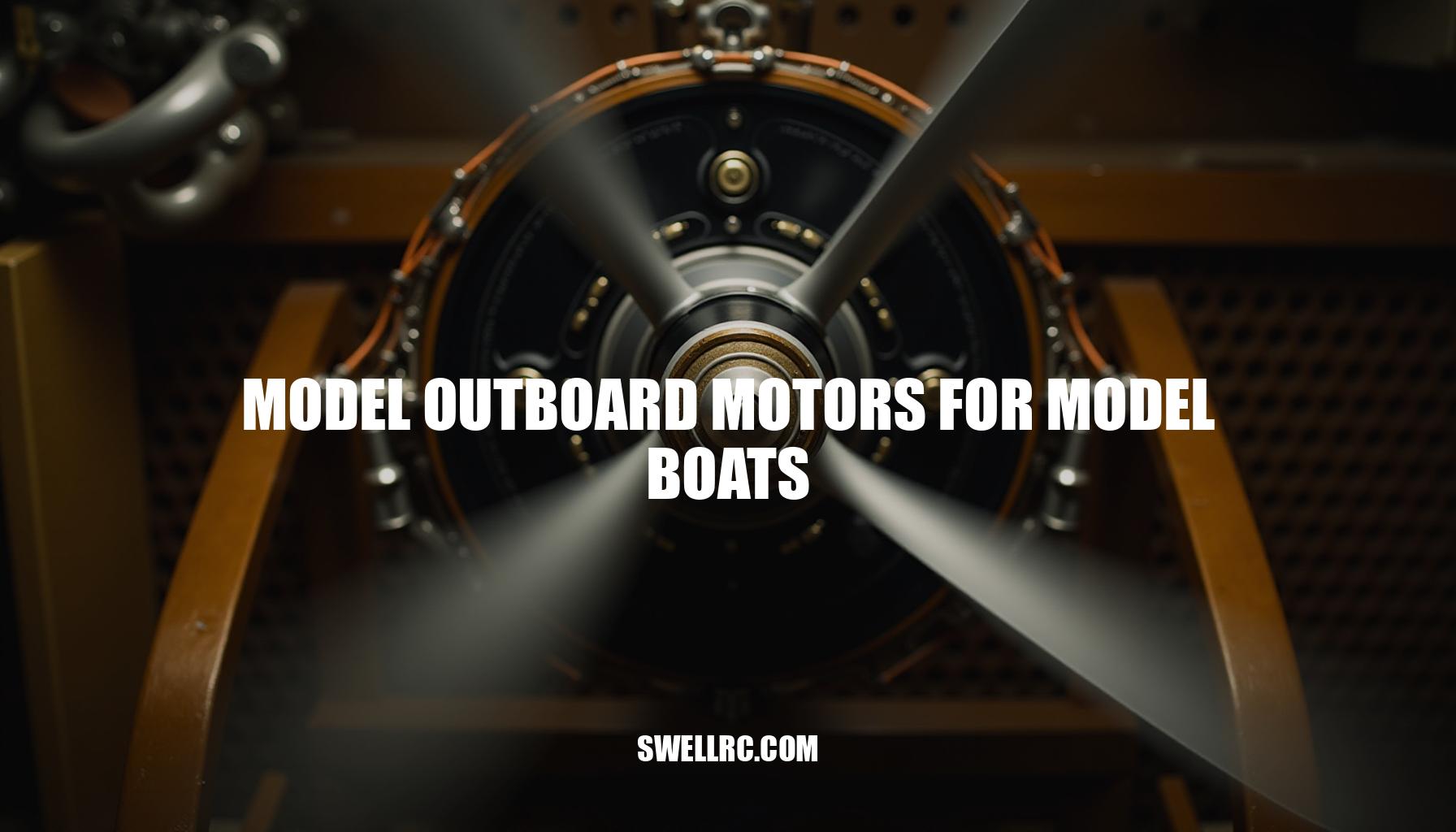Mastering Model Outboard Motors for Model Boats
I still remember the exact moment when model outboards truly clicked for me. It was during my first high-torque test run—my heart raced as the stern lifted just enough, the prop bit into the water cleanly, and the boat carved through the turns with an agility that rivaled full-size outboards. Before that run, I’d struggled with annoying cavitation and erratic trim angles that sapped performance and realism.
But once I nailed the ESC timing and fine-tuned the angle, everything transformed. The boat felt alive, responsive, and effortlessly precise.
What makes outboards so thrilling compared to inboard setups? For me, it’s all about steering with thrust vectoring—being able to guide the boat by directing its propulsion, capturing that scale realism that makes scale RC boating so addictive.
Plus, hobby-grade outboards offer the simple joy of easy swapability, letting you experiment with different motors and props without overhauling the whole rig.
With the RC boats scene growing rapidly, there’s never been a better time to dive in and master model outboard motors. Whether you’re new to the hobby or looking to sharpen your skills, this article will take you on a practical, hands-on journey—from the basics of choosing your setup to pro-level performance tuning and maintenance. Together, we’ll break down what sets top-performing outboard setups apart and give you the no-fluff advice you need to get your boat slicing through water like a true champion.
Understanding the Magic Behind Model Outboard Motors
When diving into the world of model boats, understanding how outboard motors work can make choosing or upgrading your setup much easier—and more fun. Unlike inboard motors, which sit inside the hull and turn a fixed prop shaft, outboards combine the motor, gearbox, and propeller in one unit that pivots to steer. This steering method affects low-speed control and turning radius because the entire motor/prop assembly swings to change direction, offering tighter turns but shifting the boat’s center of gravity (CG) aft and above the waterline.
By contrast, inboards use rudders for steering, which handles differently and changes weight distribution inside the hull.
The propulsion chain starts at the motor’s output shaft, transferring power through gears to the propeller. The propeller’s pitch and diameter significantly influence thrust: tighter pitches accelerate quicker but limit top speed, while larger diameters boost thrust but risk cavitation—where water bubbles reduce grip and cause wobble. Balancing these helps your hull slice smoothly through water without losing efficiency or control.
A good example is tuning your prop on a nitro outboard for just enough load to keep your engine in its sweet spot.
Power-to-weight ratio is key: lighter motors, especially electric ones, help reduce overall drag and lift the hull onto plane faster, improving the hole shot (initial acceleration). Correct mounting height also matters; mounting too low causes excess drag, while too high reduces thrust contact with water. Proper balance keeps the CG low and centered, which improves handling at varying speeds.
Control systems differ by motor type. Electric setups mainly use Electronic Speed Controllers (ESCs) for smooth throttle modulation, while nitro and gas engines rely on mechanical throttle linkages and carburetors. For radio control, tweaking expo settings and endpoints ensures both delicate low-speed steering and responsive high-speed turns—valuable when racing or navigating tight spots.
Regarding motor types, RC outboard motor electric options include brushed and brushless designs: brushed motors are simpler and cheaper but less efficient and wear out faster; brushless motors provide higher torque, longer runtime, and quiet operation. Nitro outboards (.12–.21 size range) offer strong torque and realistic engine sounds but need more maintenance and expert tuning. Small gas outboards are less common but provide good torque and run longer with proper care, albeit with noticeable noise and vibration.
| Feature | Electric (Brushed/Brushless) | Nitro Outboard | Gas Outboard |
|---|---|---|---|
| Weight | Light (improves power-to-weight ratio) | Moderate | Heavy |
| Thrust Character | High torque at low speeds; consistent thrust | Strong torque with some lag; realistic engine noise | Good torque; longer runtime |
| Control/Throttle Response | Smooth via ESC; precise | Mechanical linkage; requires tuning | Mechanical; moderate responsiveness |
| Noise | Quiet (especially brushless) | Loud; realistic engine sounds | Very loud; vibration noticeable |
| Maintenance | Low; occasional brush replacement (brushed) | High; regular tuning and cleaning | Moderate; fuel care and engine maintenance |
For those curious about electric options, exploring model boat electric motors can showcase the variety of sizes and power ratings available to match your boat’s needs. Remember, matching motor torque to hull type and weight is essential for superb acceleration, efficient top speed, and nimble handling.
As a friendly tip from someone who’s raced and repaired countless remote control marine engines: start with a lightweight, brushless electric outboard for easy, quiet operation and smooth control. Then, as you get comfortable, experiment with nitro or gas options if you crave the realism and sound of an actual combustion engine. Either way, understanding the interplay of thrust, torque, power-to-weight ratio, and motor design will boost your confidence and enjoyment on the water.
Testing and Comparing Performance: What Really Matters
After hours testing two TFL Hobby RC boats side by side, I learned how subtle tweaks can shave seconds off laps. For example, swapping from a 3-blade to a 2-blade prop and repositioning the battery forward shaved nearly 4 seconds on a 500m course, with far less propeller cavitation and improved tracking. These hands-on results reinforce what many racers sense but may overlook when dialing in their RC offshore powerboat performance.
Here are the key factors that noticeably impact lap times, stability, and reliability:
- Motor output: Beyond KV rating, torque and wattage headroom matter. An 1800KV brushless with 1200W max outperforms a similar KV motor capped at 900W, especially in chop where quick throttle response prevents stalls.
- Propeller match: Diameter, pitch, blade count, and material all influence thrust and ESC load. For example, a 48mm 3-blade aluminum prop with moderate pitch offers reliable top-end speed without overloading the ESC, while a larger diameter or aggressive pitch can cause overheating or ESC cutoff.
- Hull type and length: Deep-V hulls offer better chop penetration but need careful trim adjustments to avoid porpoising. Catamarans excel at stable, flat-water straight runs but can struggle in rough water. The chine shape influences lift and spray control; longer hulls generally maintain higher GPS speeds but sacrifice agility.
- Power source: Voltage, battery cell count, and C-rating determine consistent power delivery. High C-rating LiPos reduce voltage sag under load, preserving throttle response. Proper wiring with minimal losses and good connectors ensures efficient current flow.
- Cooling: Efficient water jacket flow and good routing prevent motor and ESC temps from exceeding 60°C, which risks component damage. I logged 55°C peak with dual water intakes routed directly over ESC trace fins—a must for sustained runs.
- Weight distribution: Battery placement fore or aft critically affects trim angle and hull attitude. Moving batteries about 5cm forward improved bow lift and lap times by ~3 seconds. Engine height also alters prop shaft angle and cavitation.
- Radio setup: Steering throw, exponential curves, and dual rates help dial high-speed stability and cornering precision. Wider steering throw boosts maneuverability but can induce twitchiness—fine-tune expo to soften response near center.
Speed vs Stability Adjustment Cheat Sheet:
| Goal | Propeller | Center of Gravity (CG) | Trim Angle | Turn Fin |
|---|---|---|---|---|
| Max Speed | 2-blade, moderate pitch | Forward 3-5cm | Neutral/slightly down | Minimal, narrow |
| High Stability | 3-blade, smaller diameter | Centered or slightly aft | Slightly up | Wider, larger surface |
Field Notes on Freshwater vs Saltwater: Saltwater introduces corrosion challenges that demand diligent flushing and use of sacrificial anodes. Saltwater’s higher density improves buoyancy but can amplify chop effects. In contrast, freshwater is gentler on electronics but may require adjustments in hull trim to maintain optimal lift and handling.
Overall, mastering propeller selection, hull setup, and ESC cooling coupled with attention to battery C rating and wiring yields the most noticeable gains during GPS speed testing. Whether you’re piloting a nimble RC offshore powerboat or pushing the limits of a 45 Cigarette RC boat, these tested insights will help optimize your setup for razor-sharp performance and dependability.
Choosing the Right Motor for Your Model Boat
Choosing the right RC boat motor for your model boat is easier with a clear, practical guide. Whether you’re piloting classic Graupner model boats or sleek Robbe model boats, matching outboard motors to your boat’s size, use case, and budget ensures confident purchase and setup.
Step 1: Define Your Mission
- Determine what you want: scale realism, sport running, or competitive racing.
- Estimate desired top speed and runtime based on your activity.
Step 2: Match by Size and Weight
The rough rule of thumb is to target about 1 to 3 watts per pound depending on your performance goal. Start by choosing your motor voltage to fit your battery setup. Then select a suitable KV (RPM per volt) that achieves the optimal propeller RPM for your boat size.
Ensure electronic speed controller (ESC) current headroom is 20–30% above your peak expected draw to prevent overheating or damage.
Step 3: Fit and Balance
Consider shaft alignment and mount height carefully. The transom must be strong enough to support the motor, and balance your model to maintain proper center of gravity (CG) for stable handling.
Step 4: Prop Compatibility
Always start with a conservative propeller size and pitch. Use operation logs—monitoring current (amps) and motor temperatures—to step up prop size safely without overloading the motor or ESC.
Step 5: Brushed vs Brushless Trade-Offs
Understand the key differences between brushed and brushless outboards to decide which suits your needs and budget.
| Feature | Brushed Outboards | Brushless Outboards |
|---|---|---|
| Cost | Lower upfront cost | Higher initial investment |
| Efficiency | Lower efficiency, more heat | Higher efficiency, cooler operation |
| Maintenance | Requires brush replacement | Minimal maintenance |
| Throttle Feel | Simpler, less smooth control | Smoother, more precise throttle response |
| Upgrade Path | Limited upgrade options | Wide variety of compatible motor/ESC combos |
Step 6: Brand and Platform Considerations
Many classic scale model ecosystems, such as the Graupner model boats platform, offer parts compatibility and modular upgrades. The Max Power W-09 RC boat is an example model showing how well-matched motors greatly enhance performance and durability.
- Small (<18″/45cm): 180–2500 KV, 5×3 to 6×4 props
- Medium (18″–30″/45–75cm): 1200–2000 KV, 6×4 to 7×6 props
- Large (>30″/75cm): 800–1500 KV, 7×6 to 8×8 props
Note: these ranges are conservative. Always verify with runtime temperature monitoring to fine-tune your setup and avoid overpropping.
By following these steps and understanding key concepts like watts per pound, ESC sizing, and prop compatibility, your boat will perform reliably and enjoyably. Don’t forget: cautious testing and temperature checks are your best tools to ensure smooth sailing and long-lasting gear.
Maintenance and Upgrades That Keep Performance at Its Peak
For those running outboard RC boats, a steadfast upkeep routine is your best ally in extending engine life, sharpening handling, and sidestepping preventable failures. Think of it like being your own veteran pit crew—practical, concise, and focused on results.
Daily & Post-Run Habits: Right after every run, especially in brackish or saltwater, give your rig a thorough freshwater rinse. Follow that with drying, inspecting the propeller and leading edges for nicks or damage, lightly re-greasing the flex shaft, checking water-cooling flow to prevent overheating, and verifying all screws and mounts are tight. This steady regime ensures model boat engine maintenance stays on point and avoids early wear.
Every 3 to 5 Runs: Pull the shaft completely for a full re-grease, examine seals and O-rings for cracks or deformation, and check motor bearings for smooth rotation. Don’t forget to inspect the ESC and connectors for signs of heat discoloration—a red flag for potential electrical troubles.
Seasonal Tasks: Time to go deep: replace bearings and seals as needed, refresh the tubing system to maintain optimal cooling, check radio box seals for water intrusion, and re-balance props to eradicate vibrations and maximize thrust efficiency.
| Maintenance Interval | Tasks |
|---|---|
| Pre-Run | Check water-cooling flow, verify screws/mounts, inspect prop and leading edges |
| Post-Run | Freshwater rinse (if salt/brackish), dry, light grease on flex shaft, inspect for damage |
| Every 3–5 Runs | Pull & re-grease shaft fully, check seals/O-rings, inspect motor bearings, examine ESC/connectors for heat spots |
| Seasonal | Replace bearings/seals, refresh tubing, check radio box seals, re-balance props |
Battery Care is Key: Storage charge your LiPos, perform internal resistance (IR) checks, and retire packs that show fatigue. Respect LiPo handling best practices to keep your power system safe and efficient.
Troubleshooting Tips: For cavitation, try lowering engine height or switching to a prop with more pitch. Thermal cutoffs often signal prop load issues—reduce load or enhance cooling. Vibrations might mean it’s time for propeller balancing or inspecting the shaft for straightness.
Upgrades Worth Your Time: Installing better water jackets dramatically improves cooling system checks. Balanced metal props elevate thrust smoothness and durability. Low-resistance connectors help minimize electrical losses, and telemetry/GPS tools empower data-driven tuning for next-level performance.
Safety first: Keep fingers clear of props during operation. Always disconnect packs before wrenching on your rig. Adhering to LiPo handling best practices is non-negotiable.
Conclusion: My Takeaway — Why Model Outboard Motors Are the Real Heart of RC Boating
Reflecting on my journey, it’s clear how pivotal mastering the core elements of model outboard tuning has been. The big levers—carefully matching motor, propeller, and hull; diligently logging temperature, amp draws, and GPS data; alongside a consistent maintenance routine—transformed my approach entirely. Performance optimization didn’t come overnight, but the moment my outboard setup finally felt “dialed” was unforgettable: stable through choppy waters, sharp and responsive in every turn, and running cooler than ever before.
This tangible progress fueled my passion and underscored the value of methodical testing and learning. For anyone driven by RC boating inspiration and eager to advance their skills, I encourage you to keep experimenting, diving into the related guides referenced earlier, and embracing the community’s endless spirit of tinkering. Every trial brings new insight, propelling your hobby progression forward and opening doors to even greater thrills on the water.
Frequently Asked Questions
- What’s the best type of motor for model boats — electric or nitro?
For most hobbyists, brushless electric outboards win on ease, efficiency, and low maintenance; they deliver instant torque and clean control. Nitro offers great sound and realism with longer pit-stop style runs, but needs more tuning and upkeep. - How do I choose the right outboard motor for my model boat size?
Start with your hull length/weight and target speed, pick a voltage (cell count) that suits the space, then choose KV to reach your desired prop RPM. Leave 20–30% ESC current headroom, and validate with conservative props, temperature checks, and amp logs. - Are model outboard motors interchangeable across brands?
Sometimes, but not always. Mount patterns, shaft diameters, and linkage geometry vary by brand and scale. Many can be adapted with aftermarket mounts or shims, but verify transom height, clamp width, and prop shaft compatibility before buying. - Can I upgrade a brushed motor to brushless in a scale RC boat?
Yes. Plan the swap as a system: motor can size, KV vs voltage, matching ESC, and a suitable prop. Reinforce mounts if needed, ensure cooling, and expect to re-trim CG and steering to handle the extra power and torque. - What factors affect speed and maneuverability in model boats?
Motor power and KV, prop size/pitch, hull type and weight distribution, voltage and battery C-rating, cooling efficiency, and radio setup all matter. Small changes in prop and CG can dramatically change acceleration, top speed, and cornering stability.



